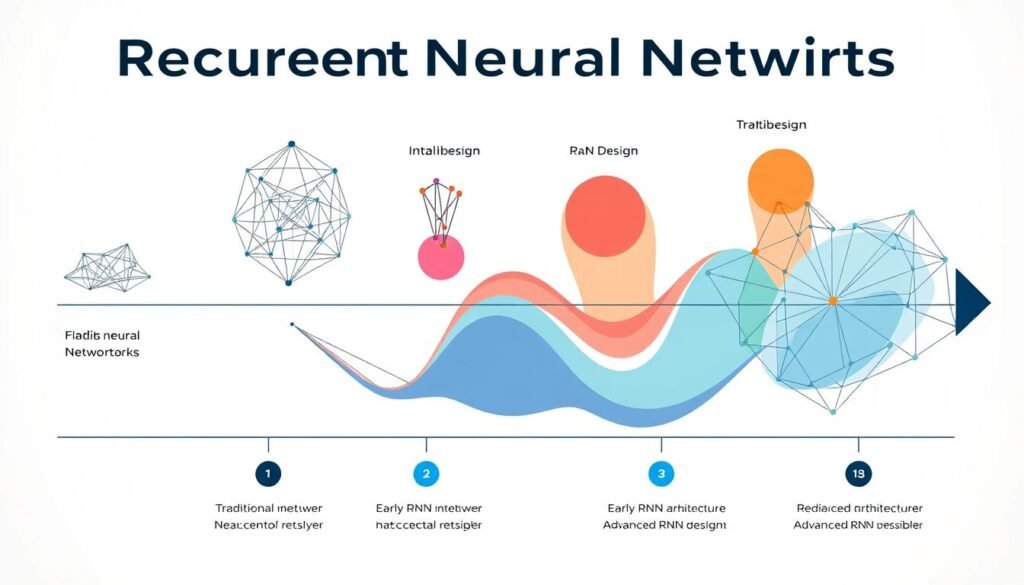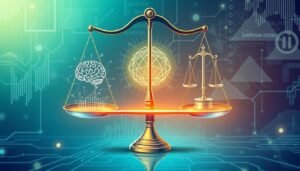In the world of deep learning, recurrent neural networks (RNN) are a big deal. They’re made for handling data that comes in a sequence. Unlike other models, RNNs can understand data that’s connected and changes over time.
This makes them perfect for tasks like understanding speech, creating text, and predicting trends. As a key part of AI RNN, they change how we process data, making it more like the natural world.
Have you ever talked to a digital assistant or seen product suggestions based on your browsing? Chances are, an RNN was involved. RNNs in deep learning learn from data that changes over time. They find patterns in sequences of data.
Imagine a system that learns as it goes, not just from a single snapshot. That’s what RNNs do. Learning about RNNs opens up how they predict the future. This is explained with examples later. RNNs are used in many areas, like finance and healthcare.
The next parts will explore RNNs in more detail. We’ll look at their core ideas, examples, and how they’re changing AI. If you’re interested in machine learning, RNNs are both fascinating and useful.
Key Takeaways:
- RNNs offer a specialized approach to analyzing sequential data, going beyond isolated data points to consider entire sequences.
- The adaptability of RNNs makes them suitable for tasks such as natural language processing and stock market forecasting.
- Understanding RNNs is essential for anyone looking to harness their power in pragmatic RNN applications.
- These networks are a cornerstone technology in modern AI applications, showcasing the ongoing integration of RNN in deep learning.
- Real-world examples serve to demystify and illustrate the substantial impact of AI RNN advancement.
- Insights into how RNNs function can offer a competitive edge in developing machine learning solutions that require sequential data interpretation.
Understanding Recurrent Neural Networks (RNN):
Recurrent Neural Networks, or RNNs, are key in handling sequential data. They remember past information, unlike traditional networks. This makes them great for tasks like language and time series analysis.

Defining RNN in the Context of Machine Learning:
In machine learning, RNNs are more than just networks. They have loops that keep information flowing. This ‘memory’ helps predict future data, like the next word or stock trends.
Key Characteristics of RNN Architectures:
RNNs have an internal state that remembers past calculations. This state is crucial for future operations. Their architecture allows for continuous processing and efficient sequence handling.
The Inner Workings of Recurrent Neural Net Models:
RNNs work by combining new inputs with past data. This creates an output that feeds back into the network. This loop keeps each step connected to the past, enabling dynamic behavior.
Exploring RNNs shows their unique ability to handle context-dependent data. They are essential for complex data analysis and prediction.
The Evolution of RNN from Traditional Networks:
The journey of rnn in machine learning has seen big changes from old neural network designs. Knowing how rnn networks have evolved helps us see their uses today. It also pushes the limits of what rnn cnn deep learning can do.
Contrasts between Feedforward and Recurrent Neural Networks
Recurrent neural nets are different from traditional feedforward nets. They can handle sequences of data, which is key for tasks needing context. Unlike feedforward nets, rnns can use past data to make better predictions.
Historical Development of RNN in Deep Learning
The history of rnn cnn deep learning is filled with important steps. Seeing these milestones shows how rnns have gotten better over time. From simple layers to complex ones, rnns have come a long way.

| Year | Development |
|---|---|
| 1980s | Introduction of basic recurrent structures in neural networks |
| 1990s | Advancements in learning algorithms for rnn, improving stability and performance |
| 2000s | Integration of rnn with convolutional neural networks for enhanced learning capabilities |
| 2010s | Breakthroughs in deep learning, expanding applications of rnn in various fields like speech and text recognition |
RNN’s Role in Sequential Data Analysis:
Traditional data analysis tools are no longer enough, especially with the growing complexity and volume of data. Rnn in machine learning steps in, offering big benefits by handling data one step at a time. It’s used in finance for rnn time series forecasting, tech for rnn text generation, and entertainment for rnn language modeling.
Machine learning models like RNNs are great at understanding the context and connections in data sequences. This skill is key for tasks where past data affects future outcomes, like in language and stock market predictions.
| Industry | Use Case | Impact of RNN |
|---|---|---|
| Finance | Stock Price Prediction | Enhances prediction accuracy by analyzing past price sequences |
| Healthcare | Patient Monitoring | Tracks health trends over time, enabling preemptive medical intervention |
| Entertainment | Script Generation | Improves creative processes by generating context-aware text |
RNNs in machine learning show their true power by adapting to time-dependent data. They’re able to predict the next word in a sentence or forecast stock market trends. RNNs capture the time-based details, offering insights that were once out of reach.
Breaking Down the RNN Architecture:
The design of rnn architecture is key in recurrent neural networks (RNN). It’s important to know how data moves through layers. At the heart of every RNN network are three parts: the input layer, hidden layers, and the output layer.
Data moves through these layers one step at a time during training. The input layer gets the sequence data first. Then, it goes through hidden layers that catch different parts of the data. The weights change as the network learns from each sequence.
This flowing and updating mechanism allows RNNs to make predictions based on prior information in a sequence, making them exceptionally valuable for tasks like language modeling and time series analysis.
A simple rnn example in python shows how these ideas work. Python is easy to read and use, helping to make complex ai rnn models clearer.
For more on how RNNs work in machine learning, check out this resource on supervised, unsupervised, and reinforcement learning. It explains how these types of learning improve AI.
RNNs are different from regular neural networks because they remember past inputs. This lets them handle data that changes over time. This is key for tasks that need to remember past information.
- Input Layer: Receives sequential input data.
- Hidden Layers: Process data in sequence, remember past inputs, and update weights.
- Output Layer: Produces the final output sequence based on learned data.
Knowing how RNNs work helps us use them better in AI. It shows how machines can learn and do more.
Long Short-Term Memory (LSTM) Networks: An Extension of RNN:
Long short-term memory (LSTM) networks are a big step up from traditional Recurrent Neural Networks (RNN). They are great at handling sequences that need to remember things for a long time. This makes them perfect for tasks that need to understand the context well.
These networks are a big deal in the world of artificial intelligence (AI) rnn technology.
Introduction to LSTM and its Significance:
LSTM networks are a special kind of RNN lstm. They can remember information for a long time, something regular RNNs can’t do well. This is because they have a special design that helps them keep or throw away data as needed.
This makes LSTMs very useful for complex tasks like understanding natural language and analyzing time-series data.
Comparing LSTM with Standard RNN Models:
LSTMs are better than traditional RNNs in many ways. They can handle information better, which helps avoid problems like the vanishing gradient. This means they can learn and remember more effectively, especially with long sequences.
Here’s a look at how LSTMs compare to standard RNNs in different AI rnn applications.
| Feature | RNN | LSTM |
|---|---|---|
| Memory Capability | Limited | Long-term |
| Gradient Stability | Low | High |
| Application Suitability | Short sequences | Long, complex sequences |
| Performance in Complex Tasks | Basic | Advanced |
The table shows why LSTMs are better for tasks that need to remember things for a long time. Their improved abilities make them key in the development of advanced AI rnn systems.
Implementing Recurrent Neural Networks in Python:
Rnn in machine learning has changed how we predict and recognize sequences in many fields. Python is perfect for this because it’s easy to use and has strong libraries. We’ll explore how to use Python for RNN models and show a simple example to help you get started.
Frameworks and Libraries for RNN Development:
Machine learning tools have made it easier to use RNNs. TensorFlow, Keras, and rnn classification Pytorch are key platforms. They help build and train RNNs with their unique features:
- TensorFlow – Offers deep learning support and a wide ecosystem.
- Keras – Easy to use, great for quick prototyping and RNNs.
- PyTorch – Good for complex models with dynamic computation graphs.
For new developers, Analytics Vidhya rnn articles are full of useful tips. They help you know when and how to use these frameworks.
Step-by-Step Example of RNN in Python:
Building a simple RNN model for text classification shows their power. Here’s a basic example using PyTorch:
- Set up the RNN model structure.
- Get the data ready for training and testing.
- Choose a loss function and optimizer.
- Train the model for several epochs.
- Check how well the model does on new data.
This example gives you real experience with RNNs. It’s key for learning in tech fields.
Learning RNNS in Python boosts your skills and opens new doors in data analytics. Start with simple models and adjust as needed for your projects.
| Framework | Core Use | Best For |
|---|---|---|
| TensorFlow | Deep learning | Large-scale Models |
| Keras | Rapid prototyping | Beginners and Professionals |
| PyTorch | Dynamic computation graphs | Research and Complex Models |
Practical Applications of Recurrent Neural Networks:
Recurrent Neural Networks (RNNs) are changing many fields by improving how we handle sequential data. They help in natural language processing, making machine translation and chatbot talks better. They also help in forecasting, impacting financial markets and weather predictions.
Case Studies: RNN in Natural Language Processing (NLP):
RNNs are key in machine learning, especially in natural language processing. They help systems like chatbots understand and respond like humans. They also improve content creation software, making it possible to generate human-like text.
RNNs Driving Advances in Time Series Forecasting:
RNNs are great at forecasting future trends in data. They are used in finance to predict stock movements, helping traders and analysts. They also improve weather forecasting models, making predictions more accurate.
RNNs are used in many areas, showing their versatility and impact. They help solve complex data analysis and forecasting challenges.
Challenges and Limitations of RNN in Machine Learning:
Recurrent Neural Networks (RNNs) are key in machine learning and deep learning. Yet, they face several hurdles. These issues can affect how well these models work, especially with complex data and fast processing needs.
Managing Complex Sequential Data and Overfitting:
RNNs can handle sequences but also face challenges. Learning long-term patterns is hard due to the vanishing gradient problem. They also risk overfitting, especially with small datasets or overly complex models.
Computational Constraints and Training Difficulties:
Training RNNs is computationally heavy. This is true for deep architectures or RNN DQN models. They need a lot of power, making them hard to use in limited settings. Also, finding the right settings and optimizing them is time-consuming and requires a lot of expertise.
In conclusion, RNNs are great for sequential data in machine learning. But, their complexity and need for lots of computing power are big challenges. To fully use RNNs, we need better machine learning methods and hardware.
Future Trends and Developments in RNN Technology:
RNN technology is on the rise, with a bright future ahead. It’s all about big advancements and new uses in AI. The work on improving RNN deep learning is changing the game in both theory and practice.
Innovations in RNN Algorithms
Today, we’re seeing big steps forward in RNN tech. People are working hard to make learning models better. They’re looking at new ways to make RNN AI work better with complex data and big datasets.
Integration of RNNs with Other AI Technologies
Another big trend is combining RNN tech with other AI innovations. Things like reinforcement learning and generative adversarial networks are being mixed with RNNs. This mix creates more powerful and flexible AI for areas like self-driving cars, healthcare, and finance.
RNN AI is not just getting bigger; it’s getting smarter. It’s all about learning from sequences in new ways. The work on RNNs is making deep learning more important in AI, changing how we use it in many fields.
Conclusion:
The journey through the world of recurrent neural networks (RNN) comes to an end. RNNs are a big win in machine learning, especially for handling sequential data. They can predict sequences, like in natural language processing and speech recognition.
Exploring RNNs shows their ability to understand time sequences. This makes them key in creating smart systems.
Looking at RNNs, we see their good and bad sides. They can handle long sequences but need a lot of training and computing power. But, new architectures like LSTMs and GRUs are solving old problems.
This shows RNNs are evolving and will keep getting better. They will help many industries grow. As we learn more and technology advances, RNNs will be crucial in AI’s future.
FAQ
What is a Recurrent Neural Network (RNN)?
A Recurrent Neural Network (RNN) is a special kind of artificial neural network. It’s designed to handle data that comes in a sequence. This lets it understand sequences, like in language translation, forecasting, and speech recognition.
How do RNNs differ from traditional neural networks?
Unlike regular neural networks, RNNs have cycles in their connections. This lets them keep information from past inputs. So, they can process sequences, not just single data points.
In what ways are Long Short-Term Memory networks (LSTMs) an improvement over standard RNNs?
LSTMs solve the long-term dependency problem. They have memory cells that keep information for a long time. This makes them better at remembering over long sequences, which is great for complex tasks.
Can you give an example of how RNNs are used in machine learning?
Sure! RNNs are used in tasks like machine translation. They take a sequence of words and translate them, considering the context of each word.
What are the main components of RNN architecture?
RNNs have input, hidden, and output layers. The hidden layers are key because they remember past inputs. The connections between these layers change during training, making the network better over time.
What are some challenges associated with RNNs?
Training RNNs can be tough because of vanishing and exploding gradients. They also struggle with long-term dependencies. Plus, they can be very computationally intensive, making training over large datasets hard.
How might the field of RNNs evolve in the future?
We’ll see better RNN algorithms to tackle current challenges. They’ll work better with other AI technologies and find new uses in different fields. This will make RNNs more efficient and capable.
Are there frameworks and libraries to help develop RNNs in Python?
Absolutely! Python has great libraries like TensorFlow, Keras, and PyTorch. They make building and training RNNs easy. These tools help simplify the process of creating RNN models.
What impact do RNNs have on time series forecasting?
RNNs have greatly improved time series forecasting. They make predictions that consider the data’s temporal dependencies. This is especially useful in finance, weather, and demand planning, where time patterns are key.
Are RNNs suitable for all machine learning tasks?
While RNNs are great for sequential data, they’re not for every task. For tasks without temporal dependencies or where sequences aren’t key, other models might be better.





















